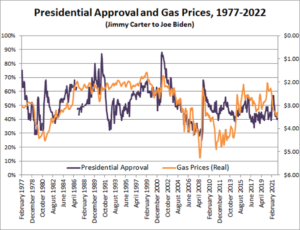At Sabato’s Crystal Ball, Kyle Kondik takes on “Gas Prices and Presidential Approval: There is some connection historically, but that connection is getting weaker,” and writes: “That a president would prefer to have lower gas prices than higher ones is obvious. That high gas prices actually do contribute to lower presidential approval is not as obvious, although there is some limited evidence for it based on what we’ve found in our research. But we also are in an era of fairly stable presidential approval ratings, meaning that it shouldn’t be surprising that whatever impact a single factor (gas prices) might have on presidential approval, the importance of that factor might be declining.” Kondik shares this chart:

E. J. Dionne, Jr. comments on Ukranian President Zelensky’s address to the U.S. Congress, and notes, “The power of Ukrainian President Volodymyr Zelensky’s video addressto Congress on Wednesday owed to something more than charisma born of clarity, tenacity and personal bravery….Five words, unlikely to make a list of Top 5 sound bites, defined why this is a battle for a generation. The confrontation in Ukraine, Zelensky declared, is a fight “to keep justice in history.”….He’s right. Allowing Russia’s aggression to succeed would mean ratifying a future that privileges power over justice, autocracy over self-determination and impunity over accountability….The potentially heartening development is that Ukraine has “woken people up to what impunity represents as a threat to global order, never mind to human rights and to human decency,” according to David Miliband, former Foreign Secretary of the U.K. and president of International Rescue Committee….“It’s woken up the liberal democracies to what is at stake,” he continued. “And it’s not just values and it’s not just interests, it’s the future, because the future is either one of impunity in which the powerful do as they please and leave the rest to do as we must, or it’s a future of accountability in which impunity is tamed.”….Democracy will not fare well in a world where impunity runs rampant….Zelensky’s performance has been commanding because of the moral commitment behind his passion. He makes an unassailable case that the struggle he’s leading is a hinge point in democracy’s story.”
I’m a bit ambivalent about posting Republican snarkage here. But in this case, it’s instructive. David Smith writes at The Guardian, “A messaging battle is under way with the White House seeking to tie Putin to the price rise. But [Republican consultant Ed] Rogers said: “Republicans have a bumper sticker. Democrats have an essay. Just see how that goes.” In other words, ‘keep it short, stupid.’ A 2014 AP/NORC study found, for example that “Overall, 41 percent of Americans report that they watched, read, or heard any in-depth news stories, beyond the headlines, in the last week” (I’d be surprised if the percentage was actually that high). Many people, including not a few swing voters, don’t have the time or inclination to read windy essays, however eloquent. Respect the target constituency’s time. Sure, it’s good to have well-thought out policy papers and articles about each issue. But don’t make them the primary messaging tools. Put more effort into getting campaign messages out with soundbites, one-liners, bumper stickers, short video clips, slogans, memes and headlines. Of course, even brevity can be overdone, and short messages must have real substance to be persuasive.
Speaking of brief messaging, SendHub has a pretty good 10-point primer on text messaging. Some excerpts: “2. Reaching a Younger Demographic….New York Times article by one political operative, no one under the age of 45 wants a phone call. Ever since peer-to-peer (P2P) texting became commonplace in the 2016 election, mobile has been a popular method for getting the word out….The SMS market is always changing and it’s important for candidates to keep up on market trends. These trends not only help you reach your audience, but they also help you stay compliant and keep your number from being spam filtered….And younger voters (aged 18-29) are almost entirely tapped into technology, so it’s crucial that campaigners use every tool in their wheelhouses to reach this key demographic….4. Did we mention open rate?….For decades, campaigns contacted voters primarily by knocking on doors and by making phone calls….According to a Medium article, “The very best at door knocking will only be able to reach 30 voters an hour at a 25% completion rate depending on the time of day. That means for every hour of human labor; you are only connecting with 5–10 voters. That means it will take a lot of hours of labor to reach enough voters to swing an election. Phone calls are even worse. Although you can contact more people per hour by calling them, they are less likely to be convinced, and the contact percentage can be as low as 2–3%.”….6. Get Responses Immediately! ….Average response rate of the text is 45%. Being that time is of the essence on a political campaign, you need to get your message read and often times you need a response! A good political field game listens to voters and collects information about who they’re supporting and what issues they value.”



